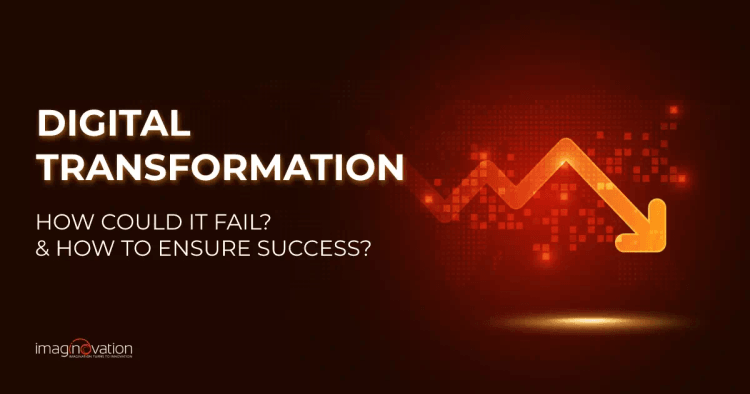Companies looking for innovation, versatility, better profits, and business efficiency prioritize digital transformation. However, statistics of digital transformation success aren’t great.
Research suggests that 70 percent of digital transformation projects do not succeed.
No matter how careful we are, most of us stumble midway when it comes to digital transformation.
AND the price of failure in digital transformation endeavors can be high.
To help you build a foolproof strategy for digital transformation, we will take you through the following:
- Various reasons for the failure of transformation efforts, and
- How you can avoid them.
Let’s begin!
Classification of Digital Transformation Failure
You can categorize digital transformation failure into three types - regression, under-performance, and failing at new tech initiatives.
- Regression is when digital transformation is not progressive. When we believe we are transforming, we're embarking on initiatives that should have been abandoned or implemented long ago.
- Underperformance happens when we fail to place larger bets on our transformation efforts – when we don't put sufficient effort into projects that can create better value for our business. In such a case, we will still benefit from digital transformation, but on a small scale.
- Businesses fail at new tech initiatives when they intend to launch a new digital product/service, but it fails, and they are then forced to abandon it.
Here are some key statistics regarding digital transformation adoption.
- Digital transformation is a change. And, 70 percent of change initiatives taken up by businesses fail. (Source)
- More than half the digital transformation efforts ultimately failed in 2018. (Source)
- 70 percent of digital transformations are unsuccessful, primarily because of resistance from teams. (Source)
- 45 percent of the leaders think their company does not have the right technology for digital transformation adoption. (Source)
- As per Mckinsey, only 16 percent of employees believe their company’s digital transformation has enhanced performance and is sustainable in the long run. (Source)
Despite everything, companies are adopting the change. Global spending on digital transformation tech & services is estimated to have expanded 10 percent in 2022. (Source)

Why Do Companies Fail at Digital Transformation?
If you believe your company can buy digital technology, implement it, and get its benefits immediately, that’s not true.
Because of the enormity of the change required to succeed, that belief is unrealistic. Companies go wrong in many places and fail when going digital.
Here are the top seven reasons for digital transformation failure.
1. Not Having The Right Mindset
Digital transformation is more about mindset and strategy than technology.
According to Kristin Moyer (Gartner), companies with incorrect transformation mindsets often find their digital initiatives either regress, underperform or fail.
People's beliefs about digital change can significantly influence their engagement in, or withdrawal from, your company's digital transformation initiatives. So much so, a correct mindset helps your employees see digital transformation as an opportunity for professional growth. But, at the same time, an incorrect one can let them believe it is infringing on their ability to display competency.
Some examples of incorrect mindset –
- Treating digital transformation as an event and not as a journey.
- CEOs, CTOs, and digital leaders are not taking the lead or setting the tone.
- Treating digital transformation as a necessary evil.
While most people oppose changes, digital leaders and CEOs can play a crucial role in bringing about the mindset change needed for successful transformations.
2. Indistinct Definitions and Goals
Have you figured out your "whys" towards digital transformation? Do you plan to adopt digital transformation because every other company seems to be doing it, and you don't want to stay behind?
Yes?
Many leaders view digital transformation as an upgraded term for what their IT department does. Yet many others focus on digital activities specific to other functions like marketing or sales.
But just a few companies have a holistic view of what digital means.
That is a big problem. Because when you lack a clear definition of digital, you cannot connect the digital strategy to your business.
And, you soon face poor digital adoption and change.
Fuzzy digital definitions bring you to a sure path of failure. It builds ineffective strategies that don’t focus on business scalability, interoperability, flexibility, and even cultural transformation.
3. Absence Of Commitment
Is your team committed to implementing and adopting the required digital change? Are they emotionally engaged with the company’s mission?
If not, you’ll find it difficult to move ahead in this journey.
Commitment is a necessary ingredient for the success of any endeavor, and digital transformation is no exception.
Companies lacking commitment find it hard to energize and inspire employees for reliable digital execution. Besides, commitment is necessary to build trust for the upcoming change, spur innovative ideas, and share best practices to reach business goals.
Also Read: A Complete Guide to Outsourcing Digital Transformation Successfully
4. An Insufficient Consensus Among Top Managers

When the team is not sufficiently briefed about the company’s digital transformation goals, many executives lack clarity on expectations and the challenges they may face.
When your company's top managers aren't looking in the same direction, it is doubtful that your digital transformation efforts will succeed.
This leads to a lack of consensus among the top managers regarding the necessity of actions and efforts.
It happens when we fail to understand the process of going digital. Or when we do not have the necessary insight to understand what needs to be done and how it will impact our bottom line.
Working in silos for a digital transformation journey should be a big no-no. It’ll make it difficult for managers of various functions to work in sync for the process.
5. Fear Of Failure
Fear of failure, for some companies, is a reason enough to hold back innovation and stick to the comfort of familiarity.
But this often has damaging effects. It creates resistance to changes, which initiates failure in your digital transformation.
As with any other project, digital transformation projects can face temporary failures making the teams scared to move forward. But it's essential to address the fear and move ahead with confidence.
There are ways to address the fear - Consider building an MVP – a minimum viable product with a mindset of continuous improvement or take small measurable steps towards success and motivate teams.
6. Talent and Skill Deficit
The expertise of your employees is one of the critical factors for a successful digital transformation. If they do not have the right skills and experience, they are bound to make mistakes and not deliver on their targets.
Transforming your business digitally means moving your business processes to the cloud to create a better customer experience and enable employees to work in collaboration from anywhere. Cloud skills are in high demand but not easy to find.
Change management is another crucial skill without which people will not accept and support the change.
But that doesn’t mean you start looking for outside talent. Instead, you can train your people on the new technologies. This way, you will empower them and bridge the skill gaps. It will also boost your employee morale and job satisfaction.
7. Falling Into The Tech Trap
Let me tell you what this technology trap is all about.
While tech is a crucial factor for transformation, be wary of your approach toward it.
Do you treat this as a shiny new toy that everyone else seems to be using, and you don’t want to be left behind?
When you pick tools that won’t help satisfy customer needs or add little value to the business model, you’ve fallen into the tech trap.
Besides, it’s not a good idea to select tools such as cloud, AI/ML, IoT, AR/VR, or Blockchain just because they are your favorite. It becomes challenging to fall in love with a single tool and obscure other essential considerations like customer experience or compliance issues.
7 Ways to Avoid Digital Transformation Failure
Although the business world is rife with stories of digital transformation debacles, we can’t let them hold us back.
Here are seven specific action points to help you avoid digital transformation failure.
1. Bring Clarity to Your Business Case

The purpose of a business case here is to offer a justified reason for digital transformation. It outlines the details of the project being undertaken and evaluates the ROI that it can generate.
Typically, digital transformation business cases can be pages and pages long with details like required tech capabilities, anticipated costs, and expected returns.
To ensure that your business case enables successful transformation, bring clarity to it by
- Keeping it brief, realistic, and free from ambiguity and unnecessary business jargon.
- Bringing accuracy. For example, when discussing costs look beyond the obvious. Make sure it includes costs of upgrading, any third-party support, or training your staff.
- Identifying both tangible and intangible benefits of the successful transformation.
- Providing well-defined transformation goals and objectives that guide business decisions.
A clear business case will make sure your team makes decisions aligned with the company’s vision.
2. Avoid The Speed Trap.
As a digital transformation leader, you can find yourself in a catch-22 situation. To get the most out of the new technology and stay competitive, you need to adopt the changes early. But not doing due diligence will lead the project to disaster.
Rushed digital transformation is riddled with poor integrations, no team involvement, poor decision-making, unrealistic strategies, etc.
It is often impractical because the actual needs of the team and business are overlooked here.
It is essential to give reasonable time to the project, as digital transformation is a process that takes time. Therefore, expecting immediate results is not advised here. Instead, a timeline considering various factors should be maintained to keep track of the status.
3. Promote a Culture of Transformation Adoption
New culture promoting digital transformation can only be formed by letting go of old habits and learning new behaviors.
Along with continuous training and meetings, focus on the right incentives. Reward behaviors that support transformation culture, like:
- Promoting a common purpose aligning with the organization’s vision.
- Pushing decisions down the entire chain of command.
- Breaking down inter-department barriers.
- Making steady efforts in learning.
4. Set Priorities
Not everything that "sounds like a good idea" is essential and should be a priority.
Remove all such transformation initiatives that do not further your company’s strategic goals.
Remember, with digital transformation, your teams will be overloaded. With clear direction on priorities, they will reach goals with ease. But if you fail to communicate preferences effectively, it'll lead to productivity loss.
Your people will either establish their priorities or stall work, not wanting to make an incorrect decision.
5. Involve Teams
If you do not involve your team in every stage of the transformation, expect poor user adoption.
Consistent communication with the teams is the key to success.
If you introduce the use of a new tech stack in your business without talking about it and informing your team, what do you think will happen?
Nobody will know what’s going on, concerns will rise, people will resist change, and the fear of the unknown will grow.
Moreover, it will result in a lack of trust in your digital transformation strategy.
The solution involves teams at every step and builds transparency and trust for the proposed change.
6. Focus On Customers

Digital transformation is a combined tech and human effort.
And organizations resist necessary changes when they fear how customers would react.
If customers are used to calling up a customer care representative on the phone, how would they deal with digital support? - Especially when the business has focused competitive advantage around customer relationships built on offering one-on-one, personalized service.
It is natural to worry that a shift to digital will disrupt their relationship with customers built on years of experience.
Therefore, begin your digital transformation strategies with a better customer experience (CX). When you create a differentiated and competitive customer experience, your business will attract new customers and retain the old ones.
7. Foster Collaboration
Any endeavor with collaborative efforts tends to pay off in the long run. Digital transformation cannot rest on the shoulders of a select few. Even with a well-defined vision, you can’t go too far without collaborative efforts by all.
You can encourage collaboration amongst teams by
- Building a digital transformation workforce.
- Sharing best practices.
- Including your customers too in this journey.
You can begin by identifying cases where there are common failures, evaluating their delivery and operational practices, working out a solution, and sharing the fix across teams.
Associate With Imaginovation For Successful Digital Transformation
As our businesses are getting digital daily, we are no longer shying away from taking the giant leap forward toward digital transformation.
You may face challenges, but you cannot let them become overwhelming roadblocks.
I’m sure you’ll remember the tips on avoiding these challenges.
Get in touch with Imaginovation to discuss your digital transformation project.
We will help you ensure you’re on the right track.
Imaginovation is an award-winning web and mobile app development company with vast experience crafting remarkable digital success stories for diverse companies.
Let's talk.
Ready to build an app, but not sure where to start?
We've got you covered. Click the button below to get started.





